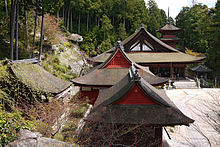Chōmei-ji
The Chōmei-ji ( Japanese. 長命 寺 ) is a Buddhist temple in the city of Ōmihachiman , Shiga prefecture in Japan . The temple name means something like temple of long life . The temple is associated with the Tendai-shu belief . Main images of the temple are three statues of Kannon , a thousand-armed, an eleven-headed and a Shō-Kannon. The Chōmei-ji is the 31st temple of the Saigoku pilgrimage route ( 西 国 三十 三 箇 所 , Saigoku sanjūsankasho ).
overview
There is no historical evidence of the foundation of Chōmei-ji. The temple legend names the Prince Regent Shōtoku as the founder and provides an explanation for the name of the temple. According to this, the legendary statesman Takenouchi no Sukune is said to have carved a prayer formula for longevity in an old willow on the later temple grounds. When Shōtoku visited this place five centuries later, the carving was still visible and an old man had asked the Prince Regent to carve three Kannon statues - the three statues that became the main images of the temple.
The Chōmei-ji was promoted by the Sasaki clan , who ruled the Ōmi province in the Middle Ages . At the end of the 12th century, a Goma Hall, a pagoda and priests' quarters were built. In 1507 the temple burned down during a rebellion against the Sasaki. After reconstruction, the temple grounds were devastated by troops from Oda Nobunaga in 1573 . The main hall and bell tower date from 1524, the pagoda and the Goma hall from 1597. All four buildings are classified as nationally important cultural assets .
literature
- Patricia Frame Rugola: The Saikoku Kannon Pilgrimage Route. Dissertation, Ohio State University, 1986.
- Valeria Jana Schwanitz and August Wierling: Saigoku - Out and about in Japan's western lands. Manpuku-Verlag, Potsdam, 2012, ISBN 978-3-9815168-0-7 .
Coordinates: 35 ° 9 '45.7 " N , 136 ° 3' 50.4" E

